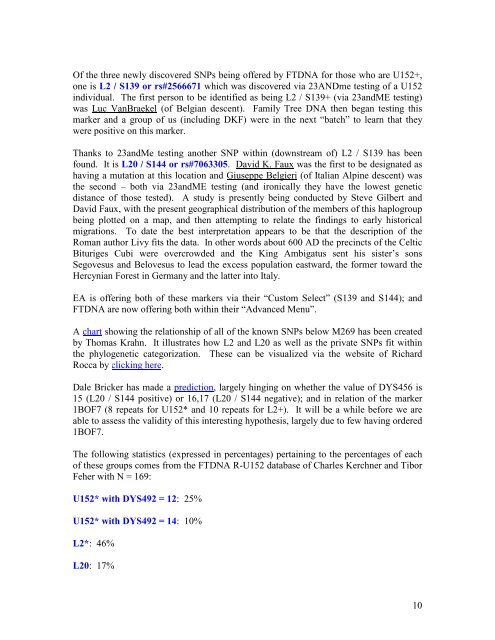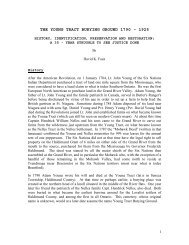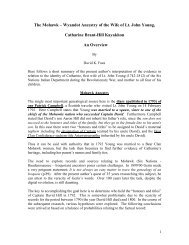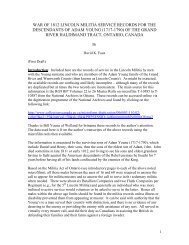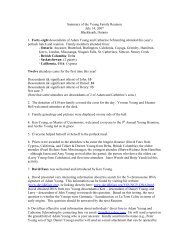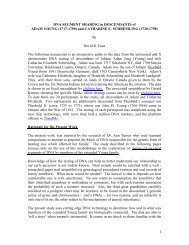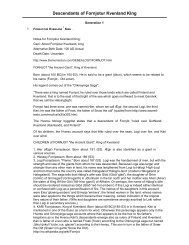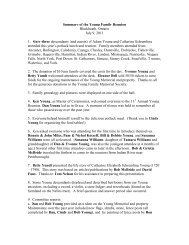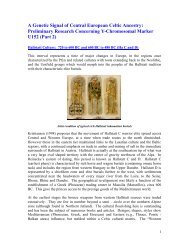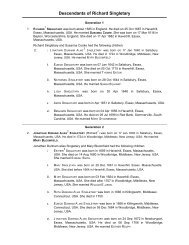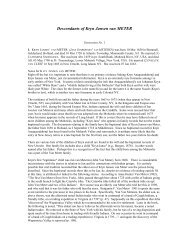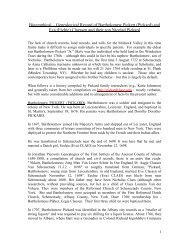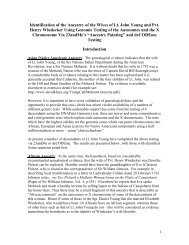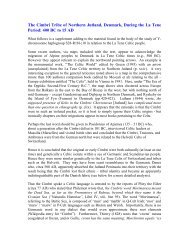Y-Chromosome Marker S28 / U152 Haplogroup R ... - Davidkfaux.org
Y-Chromosome Marker S28 / U152 Haplogroup R ... - Davidkfaux.org
Y-Chromosome Marker S28 / U152 Haplogroup R ... - Davidkfaux.org
Create successful ePaper yourself
Turn your PDF publications into a flip-book with our unique Google optimized e-Paper software.
Of the three newly discovered SNPs being offered by FTDNA for those who are <strong>U152</strong>+,<br />
one is L2 / S139 or rs#2566671 which was discovered via 23ANDme testing of a <strong>U152</strong><br />
individual. The first person to be identified as being L2 / S139+ (via 23andME testing)<br />
was Luc VanBraekel (of Belgian descent). Family Tree DNA then began testing this<br />
marker and a group of us (including DKF) were in the next “batch” to learn that they<br />
were positive on this marker.<br />
Thanks to 23andMe testing another SNP within (downstream of) L2 / S139 has been<br />
found. It is L20 / S144 or rs#7063305. David K. Faux was the first to be designated as<br />
having a mutation at this location and Giuseppe Belgieri (of Italian Alpine descent) was<br />
the second – both via 23andME testing (and ironically they have the lowest genetic<br />
distance of those tested). A study is presently being conducted by Steve Gilbert and<br />
David Faux, with the present geographical distribution of the members of this haplogroup<br />
being plotted on a map, and then attempting to relate the findings to early historical<br />
migrations. To date the best interpretation appears to be that the description of the<br />
Roman author Livy fits the data. In other words about 600 AD the precincts of the Celtic<br />
Bituriges Cubi were overcrowded and the King Ambigatus sent his sister’s sons<br />
Segovesus and Belovesus to lead the excess population eastward, the former toward the<br />
Hercynian Forest in Germany and the latter into Italy.<br />
EA is offering both of these markers via their “Custom Select” (S139 and S144); and<br />
FTDNA are now offering both within their “Advanced Menu”.<br />
A chart showing the relationship of all of the known SNPs below M269 has been created<br />
by Thomas Krahn. It illustrates how L2 and L20 as well as the private SNPs fit within<br />
the phylogenetic categorization. These can be visualized via the website of Richard<br />
Rocca by clicking here.<br />
Dale Bricker has made a prediction, largely hinging on whether the value of DYS456 is<br />
15 (L20 / S144 positive) or 16,17 (L20 / S144 negative); and in relation of the marker<br />
1BOF7 (8 repeats for <strong>U152</strong>* and 10 repeats for L2+). It will be a while before we are<br />
able to assess the validity of this interesting hypothesis, largely due to few having ordered<br />
1BOF7.<br />
The following statistics (expressed in percentages) pertaining to the percentages of each<br />
of these groups comes from the FTDNA R-<strong>U152</strong> database of Charles Kerchner and Tibor<br />
Feher with N = 169:<br />
<strong>U152</strong>* with DYS492 = 12: 25%<br />
<strong>U152</strong>* with DYS492 = 14: 10%<br />
L2*: 46%<br />
L20: 17%<br />
10


